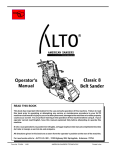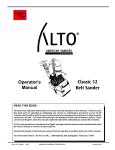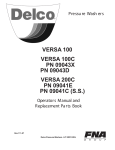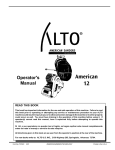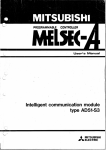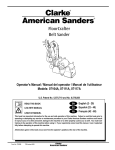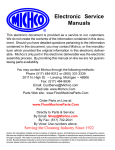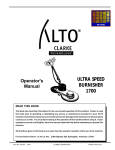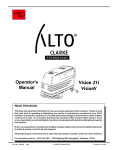Download Alto Apollo 8 Operator`s manual
Transcript
E Operator's Manual Apollo 8 Belt Sander READ THIS BOOK This book has important information for the use and safe operation of this machine. Failure to read this book prior to operating or attempting any service or maintenance procedure to your ALTO machine could result in injury to you or to other personnel; damage to the machine or to other property could occur as well. You must have training in the operation of this machine before using it. If you cannot read English, have this manual explained fully before attempting to operate this machine. Si Ud. o sus operadores no pueden leer el Inglés, se hagan explicar este manual completamente antes de tratar el manejo o servicio de esta máquina. All directions given in this book are as seen from the operator’s position at the rear of the machine. For new books write to: ALTO U.S. INC., 2100 Highway 265, Springdale, Arkansas 72764. Form No. 70141A 12/00 AMERICAN SANDERS TECHNOLOGY Printed in the U.S.A. Table of Contents Operator Safety Instructions ......................................................... 3 Introduction and Machine Specifications ....................................... 5 230V Electrical Connection Instructions ........................................ 6 How to Transport the Machine ...................................................... 7 One Person .............................................................................. 7 Two People .............................................................................. 8 Machine Set-Up ........................................................................... 8 How to Operate the Machine ...................................................... 10 Sanding Cuts and Sandpaper .................................................. 12 Chatter Wave Prevention ........................................................... 13 Sander Adjustment Procedures .................................................. 14 Dust Shoe .............................................................................. 14 Sanding Pressure ................................................................... 14 Belt Tracking .......................................................................... 15 Operating Control ................................................................... 15 Routine Maintenance .................................................................. 16 Sanding Chamber .................................................................. 16 Wheels ................................................................................... 16 Dust Bag ................................................................................ 16 Drive Belt ............................................................................... 16 Bearings................................................................................. 17 Rollers .................................................................................... 17 Troubleshooting ......................................................................... 18 Assembly Drawing #1 ................................................................ 20 Assembly Parts List #1 ........................................................... 21 Tension Assembly Drawing ........................................................ 22 Tension Assembly Parts ......................................................... 23 Assembly Drawing #2 ................................................................ 24 Assembly Parts List #2 ........................................................... 25 Assembly Drawing #3 ................................................................ 26 Assembly Parts List #3 ........................................................... 27 Wiring Diagram .......................................................................... 28 Page 2 AMERICAN SANDERS TECHNOLOGY Apollo 8 Operator's Manual OPERATOR SAFETY INSTRUCTIONS WARNING AVERTISSEMENT ADVERTENCIA DANGER means: Severe bodily injury or death can occur to you or other personnel if the DANGER statements found on this machine or in this Owner's Manual are ignored or are not adhered to. Read and observe all DANGER statements found in this Owner's Manual and on your machine. WARNING means: Injury can occur to you or to other personnel if the WARNING statements found on your machine or in this Owner's Manual are ignored or are not adhered to. Read and observe all WARNING statements found in this Owner's Manual and on your machine. CAUTION means: Damage can occur to the machine or to other property if the CAUTION statements found on your machine or in this Owner's Manual are ignored or are not adhered to. Read and observe all CAUTION statements found in this Owner's Manual and on your machine. DANGER: Failure to read the Owner's Manual prior to operating or attempting any service or maintenance procedure to your American Sanders Technology machine could result in injury to you or to other personnel; damage to the machine or to other property could occur as well. You must have training in the operation of this machine before using it. If you cannot read English, have this manual explained fully before attempting to operate this machine. DANGER: Sanding/finishing wood floors can create an environment that can be explosive. The following safety procedures must be adhered to: • Cigarette lighters, pilot lights and any other source of ignition can create an explosion when active during a sanding session. All sources of ignition should be extinguished or removed entirely if possible from the work area. • Work areas that are poorly ventilated can create an explosive environment when certain combustible materials are in the atmosphere, i.e., solvents, thinners, alcohol, fuels, certain finishes, wood dust and other combustible materials. Floor sanding machines can cause flammable material and vapors to burn. Read the manufacturer's label on all chemicals used to determine combustibility. Keep the work area well ventilated. • Spontaneous combustion or an explosion can occur when working with sanding dust. The sanding dust can ignite and cause injury or damage. Sanding dust should be disposed of properly. Always empty the sanding dust into a metal container that is located outside of any building(s). • Remove the contents of the dust bag when the bag is 1/3 full. Remove the contents of the dust bag each time you finish using the machine. Never leave a dust bag unattended with sanding dust in it. • Do not empty the contents of the dust bag into a fire. • Hitting a nail while sanding can cause sparks and create an explosion or fire. Always use a hammer and punch to countersink all nails before sanding floors. DANGER: Operating a machine that is not completely or fully assembled could result in injury or property damage. Do not operate this machine until it is completely assembled. Keep all fasteners tight. Keep adjustments according to machine specifications. AMERICAN SANDERS TECHNOLOGY Apollo 8 Operator's Manual Page 3 DANGER: Electrocution could occur if maintenance and repairs are performed on a unit that is not disconnected from the power supply. Disconnect the power supply before attempting any maintenance or service. DANGER: Electrocution could occur if machine is used on ungrounded electrical circuit. Never remove or disable the grounding supply conductor on the electrical cord. Consult an electrician if the grounding conductor is missing or if you suspect your circuit is not grounded properly. DANGER: Use of this machine with a damaged power cord could result in an electrical shock. Do not use the machine if the power cord is damaged. Do not use the electrical cord to move the machine. DANGER: Electrocution or injury could occur if the power cord is run over or damaged by the sander. Keep the cord free from under the machine to avoid contact with the sandpaper. Always lift the power cord over the machine. DANGER: Moving parts of this machine can cause serious injury and/or damage. Keep hands, feet and loose clothing away from all moving parts of the sander. DANGER: Operating a sander without all guards, doors or covers in place can cause an injury or damage. Always check to make sure that all of the guards, doors and covers are secure and in place. DANGER: Injury to the operator or bystanders could occur if the machine's power is on while performing maintenance, changing or adjusting the belt, or changing the dust bag. DANGER: Attempting to adjust the belt tracking while the machine is on can cause injury and/or damage. Do not perform belt tracking adjustments while sanding equipment is running. WARNING: Fire could occur if the machine is used on a power circuit that repeatedly trips or is undersized. Have a licensed electrician check the fuse, circuit breaker or power supply. WARNING: Failure to read and observe all safety statements found on your machine or in this Owner's Manual can result in serious injury or damage. Read and observe all safety statements. Make sure that all labels, decals, warnings, cautions, and instructions are fastened to the machine. Get new labels from your authorized American Sanders Technology distributor. WARNING: In the event of a bag fire, injury can occur to the operator if the operator is tied or strapped to equipment. Use operating belt properly ( follow procedure on page 8). WARNING: Injury to the operator or bystander can occur if protective gear is not worn while sanding. Always use eye, ear, and respiratory protection while performing any sanding operation. WARNING: Bodily injury could occur if power is applied to the machine with the power switch already in the "ON" position. Always check to assure that the power switch is in the "OFF" position before connecting power supply. CAUTION: Maintenance and repairs performed by unauthorized personnel could result in damage or injury. Maintenance and repairs performed by unauthorized personnel will void your warranty. Servicing of this unit must always be referred to an authorized American Sanders Technology distributor. CAUTION: Use of this machine to move other objects or to climb on could result in injury or damage. Do not use this machine as a step or furniture. Do not ride on this machine. CAUTION: Damage could occur to the machine if not properly kept in a dry building for storage. the machine in a dry building. CAUTION: The machine is heavy. When transporting the machine, remove the motor. Get help to lift the machine and motor. CAUTION: Serious damage to the floor can occur if the machine is left running in one spot while the sanding drum is in contact with the floor. To avoid damage to the floor, feather cut in at a normal sanding rate. Do not dwell while lowering or raising the contact wheel. Always sand at a constant rate. Page 4 Store AMERICAN SANDERS TECHNOLOGY Apollo 8 Operator's Manual Introduction and Machine Specifications MODEL CONTACT WHEEL SPEED (rpm)* ABRASIVE SPEED DUST FAN SPEED (rpm)* DUST FAN FLOW MOTOR WHEELS ABRASIVE SIZE LEVELING CONTROL OPERATING CONTROL MOTOR STARTER/PROTECTOR SANDING PRESSURE ADJMT. BEARINGS DIMENSIONS WEIGHT 07065B 07069C 2700 2250 4700 *sfm 24 meters per second 6800 5670 234 *(cfm) 92 liters per second 4 hp 208-230V 60Hz 16A 2.2kW 240V 50Hz 12A Replaceable 3½" O.D. 9 cm 291/2" x 7 7/8" 75cm x 20cm Externally adjustable Adjustable lever/grip Magnetic circuit breaker Heavy, Medium, Light Radial ball, permanently lubricated 401/2" L x15" Wx 36 3/4" H 103cm x 38cm x 93 cm 214 lbs. 97 kg NOPTENOTE: *rpm (Revolutions per minute) *sfm (Surface feet per minute) *cfm (cubic feet per minute) CAUTION: Your equipment may be inappropriate on some installations. Some softer woods used in flooring cannot support the pressure created by hard wheels. Always consult with the flooring manufacturer on the proper installation, preparation, and finishing of their product. Determine suitability of your equipment in preparing the product. AMERICAN SANDERS TECHNOLOGY Apollo 8 Operator's Manual Page 5 230V Electrical Connection Instructions CAUTION: This machine will operate only on AC frequency and on electrical voltage shown on the motor nameplate. Make sure you have the correct frequency and voltage before connecting the power cord to an outlet. The machine has a plug as shown in figure #1. This machine must be connected to an electrically ground circuit in order to protect the operator from electric shock. This machine has an approved power cord with three conductors as well as a plug with three terminals. Connect the plug into a three holed receptacle. For maximum protection against electric shock, use a circuit that is protected by a ground fault circuit interrupter. DANGER: Electrocution could occur if the machine is exposed to water or rain. Keep the machine in a dry building. DANGER: Electrocution could occur if machine is improperly connected to the electrical system. To prevent possible electric shock, always use a 3-wire electrical system connected to an electrical ground. For maximum protection against electrical shock, use a circuit that is protected by a ground fault circuit interrupter. Consult your electrical contractor. DANGER: DANGER: Page 6 Electrocution could occur if the ground pin is tampered with in any way. Do not cut, remove, or break the ground pin. Do not try to fit a three-terminal plug into a receptacle or connector body other than a three plug receptacle or connector body. If the outlet does not fit the plug, consult your electrical contractor. Electrocution could occur if the machine is used with a damaged plug or power cord. If the cords or plugs are worn or damaged in any way, have them replaced by an authorized service person or electrician. Figure 1 Extension Cords Use only an approved three-pronged extension cord with two main conductors and one earthing conductor. This machine’s power cord has a wire size of 10 gauge. This machine is equipped with a 100' power cord. When greater range is needed follow the table below to determine cable gauge of additional footage. Refer to the following chart for extension cord information. Feet/Wire Guage (Stranded Copper) Source Voltage 0 - 100' 208 6 230 10 100 - 250' Use Voltage Booster 8 If motor appears to labor or takes a considerably longer time to come up to speed, reduce sanding pressure. AMERICAN SANDERS TECHNOLOGY Apollo 8 Operator's Manual How to Transport the Machine WARNING: The machine is heavy. Remove the motor from the machine before transporting. Get help loading the machine and motor. Use proper lifting techniques. Transporting the Machine - One Person To transport the machine, follow this procedure: 1. Make sure the power cable is disconnected from the electrical outlet. 2. Disconnect the handle pigtail cord connection. (twist and pull) See figure #2. Figure 2 3. Loosen the belt tension T-screw completely. 4. Grasp the belt guard immediately above the left hand truck wheel and pull to gain access to the drive belts. Remove the drive belts. See figure #3. 5. Unscrew the motor mounting knob clear of the counterbore on chassis. See figure #4. 6. Straddle the machine. With your legs, lift the motor off of the chassis. Take the motor to worksite. 7. Lift the chassis by grasping the front and rear handle. Bring the belt guard against your chest. Take the chassis to worksite. Figure 3 To assemble the machine after transporting, follow this procedure: 1. Open the belt guard door. 2. Place the motor assembly on the chassis. 3. Screw the motor mounting knob until it stops. See figure #4. 4. Install the drive belts. 5. Tighten the belt tension T-screw only until the contact drive wheel belt does not squeal upon start up (approximately 1/2" deflection at center of span with 10 lbs. of pressure.) Do not over tighten. CAUTION: Premature bearing failure can occur if the fan belt is set too tight. The fan belt should deflect ½" at the center of the span with 5 lbs. of pressure. Figure 4 AMERICAN SANDERS TECHNOLOGY Apollo 8 Operator's Manual Page 7 How to Transport the Machine (cont.) Note: It is not necessary to adjust the fan belt independently during this procedure or during replacement. The idler pulley is factory adjusted. 6. Close the belt guard door. 7. Plug the motor pigtail in, twisting to lock. Transporting the Machine - Two People When transporting the machine with two people follow this procedure. Figure 5 1. One operator places hands under the front of the machines main casting. 2. Person #2 lifts the machine by the handle. Machine Set-Up To set-up your machine follow this procedure: 1. Familiarize yourself with the machine and read all danger, warning and caution statements. Make sure all operators of this machine have read this Owner's Manual. If they cannot read English, have the manual explained fully before allowing anyone to operate the sander. Figure 6 2. Locate the power supply. The receptacle should be compatible with the plug. The receptacle must be grounded and must be fused (30 amp) to avoid an electrical hazard. 3. Clip the dust bag to the elbow. See figure # 5. Cross the strings on the dust bag and draw tight over the flare on the elbow. Wrap the string around the elbow and secure. 4. Wind the power cord through the cable arm. See figure #6. Keep the power cord out of path of equipment. 5. Pull the draw latch forward to release the access door to gain entry to the sanding chamber. 6. Rotate the release lever forward. See Figure #7. Figure 7 Page 8 AMERICAN SANDERS TECHNOLOGY Apollo 8 Operator's Manual 7. Install a new abrasive belt by sliding the abrasive over the tension roller and contact wheel. See figure #8. 8. Rotate the release lever upward and back to tighten the abrasive belt. 9. Make sure the motor circuit breaker is in the "Off" position. Plug the pigtailed power cord into the handle. Twist the cord connection clockwise to lock. 10. Jog (turn on momentarily) the motor circuit breaker while observing the belt tracking. Follow the procedures outlined in the "Sander Adjustment Procedures" on page 13 to correct the belt tracking. There is also a label on the inside of the access door that outlines the belt adjustment. 11. Close the access door. Place the end of the draw latch over the keeper on the access door and push the draw latch flat against the mainframe to secure. Figure 8 AMERICAN SANDERS TECHNOLOGY Apollo 8 Operator's Manual Page 9 How to Operate the Machine DANGER: DANGER: DANGER: DANGER: DANGER: Page 10 Sanding/finishing wood floors can create an environment that can be explosive. Cigarette lighters, pilot lights and any other source of ignition can create an explosion when active during a sanding session. All sources of ignition should be extinguished or removed entirely if possible from the work area. Work areas that are poorly ventilated can create an explosive environment when certain combustible materials are in the atmosphere, i.e., solvents, thinners, alcohol, fuels, certain finishes, wood dust and other combustible materials. Floor sanding machines can cause flammable material and vapors to ignite. Read the manufacturer's label on all chemicals used to determine combustibility. Keep the work area well ventilated. Sanding dust can spontaneously ignite and cause an injury or damage. Sanding dust should be disposed of properly. Always empty the sanding dust into a metal container. Remove the contents of the dust bag when the bag is 1/3 full. Sanding dust can spontaneously ignite and cause an injury or damage. Remove the contents of the dust bag each time you finish using the machine. Always dispose of the dust in a metal container located outside of the building. Never leave a dust bag unattended with sanding dust in it. Do not empty the contents of the dust bag into a fire. Hitting a nail while sanding can cause sparks and create an explosion or fire. Always use a hammer and punch to countersink all nails before sanding floors. To operate the machine follow this procedure: 1. Before sanding, decide on best approach for sanding desired area. If the floor is uneven, it may be necessary to sand diagonally to the direction that the floor is laid. This will help "pull" or stretch low and high spots in the floor over a greater area, producing a flatter surface. When sanding the area, work in a way so that you are moving away from where the cord set enters the room. This will help to avoid entanglement with the cord set and eliminate the need to move the cord set out of the way so frequently. Work the area in a way that avoids interruption or termination points ( an end of pass.) Make long continuous passes. 2. Swing cable arm to side of machine opposite the direction you intend to work. Rotate elbow on dust pipe until dust bag rest on motor. This will maintain balance and sanding pressure as the dust bag fills. The machine should be operated with the dust bag in this position whenever possible. 3. Install the operating belt as follows: a. Position the operating belt around waist. b. Cross the straps at the waist. See figure #9. c. Slide the belt loop end over the handle on the control lever side. Adjust the length as needed. d. Wrap the remaining strap around the opposite side of the handle and hold it in place with your hand. WARNING: Serious operator injury could occur if the operator has tied or strapped the loose end of the operator's belt strap to the machine. Always wrap the strap so that you can let go and get away quickly in case of bag fire or explosion. 4. Turn the control switch to the "On" position. CAUTION: To prevent damage to the floor, make sure the machine is in motion when the contact wheel is engaged with the floor. 5. Feather-cut in by easing the contact wheel down onto the surface with the control lever while the sander is in motion. AMERICAN SANDERS TECHNOLOGY Apollo 8 Operator's Manual 6. When contact wheel is fully engaged with the surface, gradually adjust your pace for adequate finish removal. Keep sander in motion while the contact wheel is engaged with the surface or dwell marks will occur. 7. Move the machine in the direction of the grain in the wood whenever it is possible. Sand the surface at a constant pace. 8. Gradually feather-cut out at the termination point by easing the contact wheel up with the control lever. 9. Repeat technique described in steps 5, 6, 7, and 8 and sand back down pass just made. When completed, begin a new pass by overlapping previous pass half the width of the abrasive. Stagger termination points to prevent a distinct ridge and a better blend when edging. Figure 9 10.Empty contents of the dust bag into a metal container located outside the building. Dust bag should be emptied whenever full, as indicated on bag. WARNING: Do not overfill dust bag or serious fire may result. Never leave a dust bag containing dust unattended. Sanding dust can spontaneously ignite and cause a fire or explosion. Use only genuine American Sanders Technology replacement bags. CAUTION: An overfilled dust bag may effect machine balance and performance. Do not handle or disturb dust bag and elbow while sanding or damage to the floor may occur. AMERICAN SANDERS TECHNOLOGY Apollo 8 Operator's Manual Page 11 Sanding Cuts and Sandpaper Initial Cut Final Cuts The purpose of the initial cut is to remove old finish and gross imperfections on the floor surface. The sanding equipment should be adjusted to heavy sanding pressure setting and a coarse abrasive belt should be used. If the surface is severely damaged by deep scratches, preexisting dwell marks, uneven planks, etc., it may be necessary to sand across or diagonally to the grain to restore evenness to the surface. If these conditions are not present, the initial cut should be done in the direction of the grain. The purpose of a finishing cut is to remove the scratches produced during the initial cut. Use a fine (60 - 80 grit) grain abrasive and a reduced sanding pressure setting. If glazing, loading, or burning takes place immediately into an initial cut, select a coarser abrasive. If this should occur during an initial cut, the abrasive has dulled and must be replaced. If glazing or burning should occur immediately into a finishing cut, reduce the sanding pressure. If it should occur during a finishing cut, the abrasive has dulled and must be replaced. If the surface remains rough after a finishing cut, it may be necessary to use an even finer grain of abrasive (80 - 100 grit). Care should be taken in selecting the grit size of the abrasive. A very fine grain will close the pores on a wood floor making admission of a stain difficult. Abrasive Belts Note: All part numbers listed are for a carton of 10 belts Grain Aluminum Oxide Use Silicon Ceramic Carbide Alum.Oxide 16 grit For removing gross imperfections and restore evenness to old flooring. To remove build-up of paints and varnishes. - 945844 - 36 grit For first sanding of new flooring (maple, oak). For removing minor imperfections and finishes from old flooring. - 945842 945901 40 grit For first sanding of new flooring (oak, walnut). For removing minor imperfections and finishes from old flooring. - 945841 945902 50 grit For first sanding of new flooring (cedar, pine, fir) For cleanup of 16 grit. - 945840 945903 60 grit For cleanup from initial cut 36 - 40 grit. 945839 - 945904 80 grit For final sanding of certain hardwoods. For cleanup of initial cuts (50 grit). 945838 - 945905 100 grit For final sanding of certain hardwoods where a smooth surface is desired. 945837 - 945909 120 grit For final sanding of certain conifers. 945836 - 945910 150 grit For final sanding of certain conifers where a smooth surface is desired. 945835 - 945911 180 grit For surface roughing between coats of finish. 945834 - - Page 12 AMERICAN SANDERS TECHNOLOGY Apollo 8 Operator's Manual Chatter Wave Prevention American Sanders are designed and manufactured to the most rigid tolerances. However, after a finishing cut it is possible to see “chatter” or “waves”. The best guarantee to remove the chatter is to finish the floor with a rotating horizontal sander, such as American Sanders Technology’s Sander 16. To minimize chatter when using a belt or drum sander the following steps should be taken: 1. DRUM MARKS...are caused by the operator lowering the drum to the floor without forward traverse. These marks should be removed by cutting at a 45 degree angle to the mark. Cutting at the mark while maintaining the same path will only increase the mark depth and width. See figure #10. 2. UNEVEN WALKING SPACE...can leave lengthy “waves”. The machine cuts more material during the slower pace. Pay particular attention to a steady, even pace. 3. EXCESSIVE LIGHT CUTS...may reveal high spots on the paper/contact wheel and cause chatter. Take a heavier cut and increase the pace. Figure 10 4. DEBRIS...lodged between the paper and the drum will leave chatter. On a belt sander, debris may be adhered to the drum. Insure the drum is clean and free of debris before placing the paper on. 5. ABRASIVE QUALITY...may vary. Belt seams can be thicker on low quality paper and cause chatter. Use only American Sanders Technology specified sandpaper. Store abrasive according to manufacturers recommendation. PROPER CARE OF YOUR MACHINE CAN MINIMIZE CHATTER AND WAVES. 1. V-BELTS...can cause vibration and chatter if they are of low quality. Use only belts specified by American Sanders Technology. 2. TRUCK AND CASTER WHEELS...with flat spots, out-ofroundness, or debris adhered to their surface can cause “waves” or a “chatter effect”. Always clean and inspect all wheels before starting to sand, and before the finish cut. Replace or true the wheels if found to be out-ofround. Never allow the sander to stand on hard surfaces for lengthy periods of time. 3. DUST PICK-UP SHOES...may need adjusted differently for different materials that are to be sanded. An improperly adjusted shoe will leave trailing debris that will be run over by the wheels and cause “random waves”. 4. CONTACT WHEELS (DRUMS)...may be out-of-round and cause “chatter”. Contact your American Sanders Technology dealer for assistance to true or replace the drum. 5. BEARINGS...in the motor, drum, or fan system may become worn and induce vibration which could cause “chatter”. 6. PULLEYS...that are damaged or severly worn can induce vibration and cause “chatter”. Contact your American Sanders Technology dealer for assistance. 7. SANDPAPER TENSION...should always be released when the machine is shut off for 10 minutes or longer to avoid compression of the drum. NOTE: American Sanders Technology is not responsibile for rework of floors that are unacceptable to the customer. It is your responsibility to insure your equipment is in proper operating order, and that you use the right machine for the job. AMERICAN SANDERS TECHNOLOGY Apollo 8 Operator's Manual Page 13 Sander Adjustment Procedures DANGER: Electrocution could occur if maintenance and repairs are performed on a unit that is not properly disconnected from the power source. Disconnect the power supply before attempting any maintenance or service. DANGER: Moving parts of this machine can cause serious injury and/or damage. Keep hands, feet and loose clothing away from all moving parts of the sander. The following information provides details on how to adjust different features/controls of the sander. Dust Shoe To adjust the dust shoe follow this procedure: 1. Disconnect machine from power supply. 2. Loosen the two screws fastening the dust shoe to the chassis. 3. Adjust the dust shoe down to reduce clearance. Figure 11 4. Adjust the dust shoe up to increase clearance. 5. Align the dust shoe to the chassis and tighten screws. See figure #11. Sanding Pressure There are three pressure settings to select from: heavy, medium and light. The lower the position the heavier the setting. To change settings, raise the lever and place in desired position. See figure #12. Leveling CAUTION: The belt tracking maybe adversely effected if machine is operated unleveled. Figure 12 Page 14 AMERICAN SANDERS TECHNOLOGY Apollo 8 Operator's Manual The machine is factory set and no adjustments should be necessary. After any maintenance is performed to the carriage system, pointer must be returned to original mark (See figure 13). If it is necessary to reset level after replacing wheels follow this procedure: 1. Lower contact wheel and loosen all three clamping nuts. 2. Drive adjusting screw in, to sand heavier on the left (the drive belt side). Back adjusting screw out, to sand heavier on the right (the side opposite the drive belts). Make sure the bearing carrier follows the adjusting screw. Figure 13 3. Tighten the clamping nuts and test setting on an even surface. Make further adjustments if necessary. 4. Mark new pointer location on main frame Belt Tracking WARNING: Injury to the operator could occur if any machine adjustments are made while the motor is running. Do not attempt to make any adjustments while the machine is plugged in or running. To adjust the belt tracking follow this procedure: 1. Locate the belt tracking adjuster screw. See figure #14a. Figure 14 2. Hold the belt tracking adjuster screw and loosen the locknut. See figure #14b. 3. Rotate the tracking adjuster screw counterclockwise to move the belt in. 4. Rotate the tracking adjuster screw clockwise to move the belt out. 5. Test adjustment and tighten the locknut. Operating Control To increase the travel or extend the reach on the grip control follow this procedure: 1. Hold the control rod and loosen the locknut. See figure 15. 2. Screw the control rod in until the desired reach is found. Figure 15 3. Tighten the locknut. AMERICAN SANDERS TECHNOLOGY Apollo 8 Operator's Manual Page 15 Sanding Adjustment Procedures (CONT) To decrease the travel or reduce the reach on the grip control follow this procedure: 1. Hold the control rod and loosen the locknut. See figure #16. 2. Screw the control rod out until desired reach is found. 3. Hold the control rod and tighten the locknut. Routine Maintenance The following items need to be periodically inspected and maintained to keep your sander in good working condition. Figure 16 Sanding Chamber Periodically blow out the sanding chamber to prevent large accumulations of debris which could interfere with the performance of the tension roller. Wheels Periodically remove the debris from the truck and caster wheels. Debris can cause waves on a sanded surface. Dust Bag Remove the dust bag from the machine and shake it thoroughly to remove the sanding dust from the dust bag. Turn the dust bag inside out and machine wash in cold water to prevent pore blockage and loss of dust recovery. Drive Belt Periodically check the drive belt tension. See the adjustment procedure on page 5. Page 16 AMERICAN SANDERS TECHNOLOGY Apollo 8 Operator's Manual Bearings Periodically check the bearings for wear or damage according to the following schedule: Guide rollers Idler pulley Fan shaft Tension roller Arbor shaft Motor shaft after 1st 650 hrs. after 1st 1500 hrs. after 1st 2500 hrs. after 1st 2500 hrs. after 1st 5000 hrs. after 1st 5000 hrs. Rollers Periodically check the guide rollers and the tension roller for wear. AMERICAN SANDERS TECHNOLOGY Apollo 8 Operator's Manual Page 17 Troubleshooting Problem Cause Action Drive belts slip. (Squeaking or squealing sound) Insufficient tension. Tension drive belt as described in adjustment procedures. (See pg. 7) Worn belts. Replace belts. Squealing, growling or grinding noise coming from machine. Damaged and/or worn bearing. Remove drive belts, rotate arbor motor, fan, shafts and idler pulley to locate dragging or rough bearing. Contact an authorized ALTO dealer. Dust pickup is poor. Dust bag is over 1/3 full. Empty contents of bag. Dust bag is dirty. Shake debris from bag and wash. Dust shoe is improperly adjusted. Readjust dust shoe. Motor will not start. Dust chute is obstructed. Remove fan cover and clear throat. Defective motor starter. Contact an authorized ALTO dealer. Defective start capacitor. Contact an authorized ALTO dealer. Defective electronic start switch. Contact an authorized ALTO dealer. Low voltage from poor connection. Contact an authorized ALTO dealer. Motor runs sluggishly. Motor circuit breaker trips/ repeatedly trips. Defective motor. Contact an authorized ALTO dealer. No power. Check power supply and connections. Low voltage from excessive footage, undersized extension cord, or poor connection. Locate power source nearer to work site. Decrease sanding pressure. Defective run capacitor. Contact an authorized ALTO dealer. Defective motor. Contact an authorized ALTO dealer. Excessive load. Contact an authorized ALTO dealer. Defective electronic start switch. Contact an authorized ALTO dealer. Defective motor starter. Contact an authorized ALTO dealer. Low voltage from poor connection. Contact an authorized ALTO dealer. Uneven cuts. Page 18 Defective motor. Contact an authorized ALTO dealer. Defective capacitor. Contact an authorized ALTO dealer. Leveling out of adjustment. Readjust leveling. Fig. 13 page 15. Abrasive belt tracking. Adjust belt to track towards the edge of drum with deepest cut. AMERICAN SANDERS TECHNOLOGY Apollo 8 Operator's Manual Troubleshooting Problem Cause Action Burning or glazing. Dull abrasive. Replace abrasive. Excessive sanding pressure. Decrease sanding pressure setting. (Fig. #12, page 14). Too fine of an abrasive belt. Use coarser abrasive. Dull abrasive. Replace abrasive. Too fine of an abrasive belt. Use a coarser abrasive belt. Insufficient sanding pressure. Increase sanding pressure setting. (Fig. #12, page 14). Debris on wheels. Remove and clean wheels. Flat spot on tire(s). Replace tires. Slow cutting. Waves on sanded surface. Chatter marks on sanded surface. See Chatter Wave Prevention, (Close evenly spaced ripples) page 13. See Chatter Wave Prevention, page 13. Difficult to actuate tension release Debris interferes with mechanism Blow out sanding chamber. lever. Remove and disassemble mechanism. Clean out. Abrasive belt hunts (seeks). Abrasive belt will not track. Abrasive belt tears along its length. Worn sleeve bearing. Replace. Galled linkages. Lubricate with WD-40. Worn washers. Replace (items #84 & 88, pg. 20,21). Worn sleeve bearing. Check for excessive play, replace. High edges on contact wheel. Contact an authorized ALTO dealer or replace the contact wheel. Extreme difference in side-to-side Replace abrasive belt. length of belt. High edge on contact wheel. Check several different abrasive belts. Contact an authorized ALTO dealer or replace the contact wheel. Debris built-up on (top) tension roller. Clean tension roller. AMERICAN SANDERS TECHNOLOGY Apollo 8 Operator's Manual Page 19 AMERICAN SANDERS TECHNOLOGY Apollo 8 Belt Sander Assembly Drawing #1 12/00 10 38 5 11 4 6 9 8 12 1 7 3 50 13 14 2 15 16 9 Note: *Tension asm. breakdown and parts list are on page 22 and 23 1 *68 17 18 19 20 21 57 58 22 23 24 25 59 9 56 26 55 27 16 28 14 54 42 46 47 18 9 29 65 63 62 61 65 60 66 5 36 36 53 41 39 52 48 39 67 45 44 64 30 31 32 31 33 34 35 41 65 36 43 53 39 41 4339 Page 20 36 AMERICAN SANDERS TECHNOLOGY Apollo 8 Operator's Manual AMERICAN SANDERS TECHNOLOGY Apollo 8 Belt Sander Assembly Parts List #1 12/00 Ref No. Part No 1 2 3 4 5 6 7 8 9 10 11 12 13 14 15 16 17 18 19 20 21 22 23 24 25 26 27 28 29 30 31 32 33 34 85517A 55710A 77057A 22302AK 50765A 66545A 61411A 86206A 962823 60015A 58691A 60014A 86112A 51190A 57714A 66972A 67464A 65309A 51172A 61641A 51171A 57844A 66189A 87034A 962244 86110A 81209A 23423CK 66913A 67812A 51112A 67821A 60715B 29403CK Description Screw, 10-24 x ½ PN Latch Label, Belt Tracking Door Access Wheel, Contact Pin Access Door Pad, T-Screw Screw, Set, ¾-10 x 3 Screw, ¼-20 x ½ PN Lever, Pressure Adj. Spring, Pressure Bracket, Pressure Adj. Screw 3/8 -16 x 3/4 Bearing Ring, Retaining ¾" Dia. Retainer, Bearing Shaft, Arbor Key, ¼ x 7/8 Bearing Carrier, Bearing Bearing Ring, Retaining Pulley, Drum Retainer, Pulley Screw, 3/8 -16 x x ¾" Screw, 3/8 -16 x 1 Nut, ½-13 Flanged Frame, Truck Retainer, Bearing Spacer Bearing Spacer Bolt, Pivot Yoke, Wheel Qty 5 1 1 1 2 1 1 1 11 1 1 1 3 2 1 2 1 2 1 1 1 1 1 1 1 4 1 1 1 1 2 1 1 1 Ref No. 35 36 37 38 39 40 41 42 43 44 45 46 47 48 49 50 51 52 53 54 55 56 57 58 59 60 61 62 63 64 65 66 67 68** Part No 60101A 87003A 50933A 962988 902606 Ref. only 747304 87700A 19611A 920196 833401 82504A 60514A 19610A 87029A 87000A 50837A 67862A 67810A 21401A 68010A 81215A 815051 64467A 920110 87030A 81106A 68674A Page 11 87101A 85729A 67890A 962184 Description Qty Axle, Caster 1 Washer 4 Retainer, Spring 1 Screw, ¼-20 x 1¼ 1 Bearing 10 Hub (included in Ref. #43) 2 Ring, Retaining 8 Screw, ¼-20 x ½ 1 Wheel Asm, Rear Caster 2* Nut, ½ -13 1 Spacer 1 Pin, Clevis, 5/16 x ¾ 1 Axle, Truck 1 Asm. Truck Wheel 3* Washer ¾ 1 Washer, Flat 3 Spring, Compression 1 Spacer 3 Spacer 2 Carrier, Bearing 1 3 Stud, 3/8-16 x 3/8-24 x 1½ Nut, 3/8-24 Serrated Flange 3 Knob 1 Lever, Release 1 Nut, 5/16-18 ESNA 1 Retainer, Drum 1 Nut, ¾-10 1 Plate, Drum, End 1 Abrasive Ref Washer, ½ Lock 1 Shaft Wheel 3 Spacer Wheel 2 Screw Set ¼-20 x 3/8 2 Tension Assembly 1 Note: Kindicates a change has taken place since last publication of this manual Note: *Includes Hub and Tire (Machined) Note: **Tension Asm. breakdown and parts list on page 22 & 23 AMERICAN SANDERS TECHNOLOGY Apollo 8 Operator's Manual Page 21 AMERICAN SANDERS TECHNOLOGY Apollo 8 Belt Sander Tension Assembly Drawing 10/00 1 2 3 2 1 23 22 24 25 4 7 5 6 5 14 21 7 13 8 15 9 18 19 10 20 11 4 8 8 26 12 17 Page 22 16 AMERICAN SANDERS TECHNOLOGY Apollo 8 Operator's Manual AMERICAN SANDERS TECHNOLOGY Apollo 8 Belt Sander Tension Assembly Parts List 10/00 Ref No. Part No 1 2 3 4 5 6 7 8 9 10 11 12 13 14 15 16 17 18 19 20 21 22 23 24 25 26 747380 902567 67201B 920296 81102A 80020A 14701A 81501A 66537A 50772A 50773A 797301 53410A 50719A 961014 61804A 65709A 80018A 87502A 87503A 50770A 81303A 60150A 50771A 67465A 980018 Description Retaining Ring 9/16 Bearing Roller Nut, 10-24 Nut, ¼-20 Shoulder Bolt, ¼ x 1 Guide, Roller Asm. Pushnut ¼ Pin Draw Weldmt.,Lever Support, Tension Arm Retaining Ring 5/8 Spring, Tension Boot, Tension Spring Shoulder Bolt, ¼ x 3/8 Cam Weldment Connecting Link Shoulder Bolt, ¼ x ¼ Washer, ¼ Bowed Washer ¼ Beveled Draw Link Nut, ¼-28 Jam Aduster, Tracking Carriage, Roller Shaft, Roller Washer, Nylon Qty 2 2 1 3 2 1 2 4 1 1 1 1 1 1 2 1 1 2 4 4 2 1 1 1 1 1 AMERICAN SANDERS TECHNOLOGY Apollo 8 Operator's Manual Page 23 AMERICAN SANDERS TECHNOLOGY Apollo 8 Belt Sander Assembly Drawing #2 12/00 12 22 4 21 24 23 25 13 20 6 11 76 3 7 19 18 17 10 16 8 15 14 2 9 1 27 31 29 72 26 30 21 73 32 33 71 70 34 35 36 37 38 39 40 41 69 67 66 68 52 50 65 64 42 43 44 63 55 62 45 58 53 54 56 57 59 74 60 61 75 51 50 46 50 47 49 48 Page 24 AMERICAN SANDERS TECHNOLOGY Apollo 8 Operator's Manual AMERICAN SANDERS TECHNOLOGY Apollo 8 Belt Sander Assembly Parts List #2 12/00 Ref No Part No. 1 2 3 4 6 7 8 9 10 11 12 13 14 15 16 17 18 19 20K K 21 22 23 24 25 26 27 28 29 30 31 32 33 34 35 36 37 38K 41945A 45604A 962330 73715A 170674 697502 980614 962823 47378A 41305A 41304A 22904A 962244 87034A 51032A 66189A 57712A 915098 44639A 44664A 920342 32357A 64460A 962870 52769A 85703A 68394A 65304A 65959A 51024A 65960A 81202A 87002A 34264A 23301A 61602A 902567 22126C Description Qty Motor, Cord Plug Screw, 6-32 x 3/8 Plate, Elec./Fire Warning Wire, Nut Strain, Relief Washer, ¼ Screw, ¼-20 x ½ Pn Switch, Start Capacitor, Start Capacitor, Run Enclosure, Motor Start Screw, 3/8 -16 x ¾ Hx Retainer, Pulley Belt, Fan Pulley, Motor Ring, Retaining 11/8 Key, ¼ x 1½ Motor, 4HP 230V 60Hz Motor, 2.2kW, 240V 50Hz Nut, 3/8-16 ESNA Cover, Handle Handle, Motor Screw, 3/8-16 x 1 BT Cover, Fan Screw, 3/8-16 x 1½ Hx Screw-T Knob, Motor Mounting Mount, Motor Front Belt, 3V x 375 Mount, Motor Rear Nut, 7/16 LH Washer Gasket, Fan, Cover Fan Collar, spacer Bearing Cover, Fan 1 1 4 1 2 1 2 2 1 2 1 1 1 1 1 1 1 1 1 1 4 4 1 1 1 4 1 1 1 1 1 1 1 1 1 1 1 1 Ref No Part No. 39 40 41 42 43 44 45 46K 47 48 49 50 51 52 53 54 55 56 57 58 59 60 61 62 63 64 65 66 67 68 69 70 71K 72 73 74 75 76 65302A 67445A 85813A 51111A 877304 66169A 80017A 23808A 85700A 31221A 66932A 85517A 81102A 68393A 60623A 85702A 171101 60414A 67875A 57801A 902619 66170A 962216 81108A 920110 68010A 86111A 980657 61600A 67614A 66971A 31232A 25906A 87700A 64489A 930093 74045A 77234A Description Qty Key Shaft, Fan Screw, 5/16-18 x 1 Hx Bearing Ring, Retaining Pulley, Fan Bolt, Shoulder, 3/8 x ¾ Guard, Belt Screw, ¼-20 x 1 Hx Bumper, Side Retainer, Side, Bumper Screw, 10-24 x ½ Nut, ¼-20 ESNA Tube, Latch Bracket, Latch Screw, ¼-20 x 1¾ Nut, 3/8 -16 Serrated Flange Arm, Idler Spacer Ring, Retaining Bearing Pulley, Idler Screw, 3/8 -16 x 1¼ Nut, 3/8 -24 Nut, 5/16 -18 ESNA Stud, 3/8 -16 x 3/8 -24 x 1½ Screw, ¼-20 x ½ Washer ¼ Lock Clip Shoe, Dust Retainer, Bumper Bumper, Front Mainframe Screw, ¼-20 x ½ B.H. Handle, Front Rivet Label, Warning, Moving Parts Label, Warning, Lifting 1 1 3 1 1 1 1 1 1 1 1 8 2 1 1 1 1 1 1 1 1 1 1 1 1 1 1 1 1 1 1 1 1 4 1 2 1 1 Note: Kindicates a change has taken place since last publication of this manual Motor Parts Not Illustrated Part # 52768A 53998A 52769A Description Front Cover Fan Fan Cover Qty. 1 1 1 Part # 51188A 902547 40316A Description Bearing Front Bearing Rear Armature Assembly Qty. 1 1 1 AMERICAN SANDERS TECHNOLOGY Apollo 8 Operator's Manual Page 25 AMERICAN SANDERS TECHNOLOGY Apollo 8 Belt Sander Assembly Drawing #3 12/00 7 6 3 9 18 16 10 12 4 20 17 22 21 11 5 8 14 13 52 2 1 15 32 31 33 50 51 34 29 7 12 29 35 37 30 13 36 24 28 27 38 39 32 49 23 43 44 45 43 46 13 25 24 40 47 48 42 41 26 25 Page 26 AMERICAN SANDERS TECHNOLOGY Apollo 8 Operator's Manual AMERICAN SANDERS TECHNOLOGY Apollo 8 Belt Sander Assembly Parts List #3 12/00 Ref. No 1K 2 3K 4K 5 6 7 8 9K 10K 11 12 13 14 15 16 17 18 19 20K 21 22 23 24 Part No. 42201A 42302A 962065 41706A 43501A 85313C 962794 980650 980607 22127C 41411A 48901A 962015 920110 80022A 898203 25603A 962481 81102A 64405A 21904C 60724A 85818A 60016A 86200A Description Cord Set 230V 60 Hz Cord Set, 240V 50 Hz Screw, 8-32 x ¼ Connector, NEMA Inlet, NEMA Screw, 6-32 x 3/8 Screw 10 x 24 x 1 Washer, 3/16 Lock Washer, 1106 Cover, Switch, Box Switch, Circuit Breaker Asm., Wire Screw, 10-24 x 3/8 Nut, 5/16 - 18 ESNA Bolt, Shoulder ½ x 5/8 Spacer Lever, Control Screw ¼-20 x 1¼ Nut ¼-20 ESNA Handle, Steering Clamp, Handle Belt, Operating Screw, 5/16 -18 x 2½ Pipe, Handle Screw, Set 3/8- 16 x 5/8 Qty Ref. No Part No. Description 1 1 3 1 1 4 5 7 4 1 1 1 5 4 1 1 1 2 2 1 1 1 1 1 2 25 26 27 28K 29 30 31** 32 33 34 35 36K 37 38 39 40 41 42K 43 44 45 46 47 48 49 50 51 52** NI 962288 82104A 85816A 20704C 980699 69441A 51074A 80035A 53537A 920204 67150A 45608A 60401A 62800A 60721A 41707A 41917A 23200C 980022 53538A 925036 66150A 920342 980651 38109A 49023A 48901A 85517A 77039B Screw, 3/8 -16 x 1 Nut, ¾ NPS Screw, 5/16 -18 x 1¾ Box, Switch Washer, 1110 Bracket, Control Lever Clamp, Cable Bolt, Shoulder, 3/8 x1¼ Rod, End Nut, 3/8 -24 Rod, Control Plug, NEMA Arm, Cable Elbow, Dust, Pipe Bag, Dust Connector Cord, Interconnect Mount, Control, Handle Washer, Wave Rod, End Pin, Cotter Pipe, Dust Nut, 3/8 -16 ESNA Washer, 3/8 -Plain Seal, Dust Pipe Wire Asm. Wire Asm. Gnd Screw 10-24 x ½ Label "Made in USA" Note: Kindicates a change has taken place since last publication of this manual Qty 5 1 1 1 3 1 2 2 1 1 1 1 1 1 1 1 1 1 2 1 1 1 1 1 1 2 1 2 1 NOTE: **#31 & #52 only one shown AMERICAN SANDERS TECHNOLOGY Apollo 8 Operator's Manual Page 27 AMERICAN SANDERS TECHNOLOGY Apollo 8 Belt Sander Wiring Diagram 4/95 Page 28 AMERICAN SANDERS TECHNOLOGY Apollo 8 Operator's Manual ALTO® PRODUCT SUPPORT BRANCHES U. S. A. Locations HEAD OFFICE European Locations PRODUCTION FACILITIES ALTO U.S. Inc., St. Louis, Missouri 390 S. Woods Mill Rd., Suite 300 Chesterfield, Missouri 63017-3433 PRODUCTION FACILITIES ALTO U.S. Inc., Springdale, Arkansas 2100 Highway 265 Springdale, Arkansas 72764 (501) 750-1000 Customer Service - 1-800-253-0367 Technical Service - 1-800-356-7274 ALTO U.S. Inc., Bowling Green, Ohio 43402 1100 Haskins ALTO U.S. Inc., Clearwater, Florida 33765 1500 N. Belcher Road ALTO Danmark A/S, Aalborg Blytaekkervej 2 DK-9000 Aalborg +45 72 18 21 00 ALTO Danmark A/S, Hadsund Industrikvarteret DK-9560 Hadsund +45 72 18 21 00 SALES SUBSIDIARIES ALTO Canada Ltd., Rexdale Ontario 24 Constellation Ct. (416) 675-5830 ALTO Overseas Inc., Sydney (Australia) 1B/8 Resolution Drive Caringbah NSW 2229 +61 2 9524 6122 SERVICE FACILITIES ALTO U.S. Inc., Carlstadt, New Jersey 07072 150 Commerce Road (201) 460-4774 ALTO U.S. Inc., Elk Grove, Illinois 60007 2280 Elmhurst Road (847) 956-7900 ALTO U.S. Inc., Denver, Colorado 80204 1955 West 13th Ave. (303) 623-4367 ALTO U.S. Inc., Houston, Texas 77040 7215 North Gessner Road SALES AND SERVICE FACILITIES ALTO U.S. Inc., Madison Heights, Michigan 48071-0158 29815 John R. (810) 544-6300 ALTO U.S. Inc., Marietta, Georgia 30062 1355 West Oak Common Lane (770) 973-5225 CLARKE TECHNOLOGY AMERICAN SANDERS TECHNOLOGY A.L. COOK TECHNOLOGY Customer Service Headquarters and Factory 2100 Highway 265 Springdale, Arkansas 72764 (501) 750-1000 Technical Service 1-800-356-7274 ALTO Cleaning Systems Asia Pte Ltd., Singapore 271 Bukit Timah Rd. #04-11 Balmoral Plaza Singapore 259708 +65 8366 455 ALTO Deutschland GmbH, Frondenberg (Germany) Ardeyer Str. 15 D-58730 Frondenberg +49 2373 754 200 ALTO Cleaning Systems (UK) Ltd., Penrith Gilwilly Industrial Estate Penrith Cumbria CA11 9BN +44 1768 868 995 ALTO France S.A. Strasbourg B.P. 44, 4 Place d’Ostwald F-67036 Strasbourg Cedex 2 +33 3 8828 8400 ALTO Nederland B.V. Vianen Stuartweg 4C NL-4131 NJ Vianen +31 347 324000 ALTO Sverige AB, Molndal (Sweden) Aminogatan 18 Box 4029 S-431 04 Molndal +46 31 706 73 00 ALTO Norge A/S, Oslo (Norway) Bjornerudveien 24 N-1266 +47 2275 1770 AMERICAN SANDERS TECHNOLOGY U. S. WARRANTY This ALTO Industrial/Commercial Product is warranted to be free from defects in materials and workmanship under normal use and service for a period of one year from the date of purchase, when operated and maintained in accordance with American Sanders Technology's Maintenance and Operations Instructions. This warranty is extended only to the original purchaser for use of the product. It does not cover normal wear parts such as electrical cable or V-belts. If difficulty develops with the product, you should: (a). Contact the nearest authorized American Sanders Technology repair location or contact the American Sanders Technology Service Operations Department, 2100 Highway 265, Springdale, Arkansas 72764, for the nearest authorized American Sanders Technology repair location. Only these locations are authorized to make repairs to the product under this warranty. (b). Return the product to the nearest American Sanders Technology repair location. Transportation charges to and from the repair location must be prepaid by the purchaser. (c). American Sanders Technology will repair the product and or replace any defective parts without charge within a reasonable time after receipt of the product. American Sanders Technology's liability under this warranty is limited to repair of the product and/or replacement of parts and is given to purchaser in lieu of all other remedies, including INCIDENTAL AND CONSEQUENTIAL DAMAGES. THERE ARE NO EXPRESS WARRANTIES OTHER THAN THOSE SPECIFIED HEREIN. THERE ARE NO WARRANTIES WHICH EXTEND BEYOND THE DESCRIPTION OF THE FACE HEREOF. NO WARRANTIES, INCLUDING BUT NOT LIMITED TO WARRANTY OF MECHANTABILITY, SHALL BE IMPLIED. A warranty registration card is provided with your American Sanders Technology product. Return the card to assist American Sanders Technology in providing the performance you expect from your new floor machine. ALTO U.S. Inc., 2100 Highway 265, Springdale, Arkansas 72764 AMERICAN SANDERS TECHNOLOGY reserves the right to make changes or improvements to its machine without notice. Always use genuine American Sanders Technology Parts for repair. AMERICAN SANDERS TECHNOLOGY 2100 Highway 265 Springdale, Arkansas, 72764






























